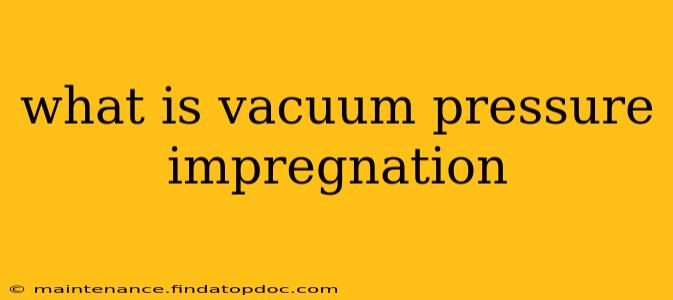Vacuum pressure impregnation (VPI) is a process used to thoroughly saturate porous materials, like wood, composites, or electrical coils, with a liquid resin or other substance. This process is crucial in various industries for enhancing material properties, improving performance, and extending the lifespan of products. It's a powerful technique that leverages pressure differentials to force the liquid deep into the material's pores, achieving a level of penetration unmatched by simple dipping or brushing methods.
How Does Vacuum Pressure Impregnation Work?
The VPI process typically involves these steps:
-
Vacuum Stage: The porous material is placed inside a sealed chamber, and a vacuum is applied. This removes air from the material's pores, creating a void that the impregnating liquid can readily fill. This is critical for effective penetration; otherwise, air pockets would prevent complete saturation.
-
Pressure Stage: After the vacuum phase, the impregnating liquid is introduced into the chamber. High pressure is then applied, forcing the liquid deep into the material's pores, filling even the smallest voids. The pressure overcomes the surface tension of the liquid and any residual air resistance, ensuring complete penetration.
-
Pressure Release and Cure: Finally, the pressure is slowly released, and the impregnated material is removed from the chamber. Often, a curing process follows to solidify the liquid resin, creating a permanently bonded structure. The curing process parameters depend heavily on the type of resin used.
What are the Benefits of VPI?
The benefits of using VPI are numerous and span several applications:
-
Improved Mechanical Properties: VPI can significantly enhance the strength, stiffness, and durability of materials by filling microscopic voids and cracks, reducing internal stress concentrations.
-
Enhanced Electrical Insulation: In electrical applications, VPI improves dielectric strength and reduces the risk of electrical breakdown by filling voids and preventing moisture penetration.
-
Increased Water Resistance: VPI provides excellent waterproofing by filling the pores, making the material resistant to moisture damage and degradation. This is especially important for outdoor applications.
-
Reduced Porosity: By filling pores, VPI minimizes surface irregularities and improves the surface finish of materials.
-
Corrosion Protection: The impregnating liquid can often act as a corrosion inhibitor, further enhancing the longevity of the treated material.
What Materials Can Be Treated with VPI?
The versatility of VPI means it can be applied to a wide range of materials:
-
Wood: Used to improve dimensional stability, water resistance, and durability of wooden components.
-
Composites: VPI helps improve the mechanical properties and reduce delamination in composite materials.
-
Electrical Coils and Transformers: Used to enhance insulation and extend the lifespan of electrical equipment.
-
Porous Metals: VPI can improve the strength and corrosion resistance of certain porous metals.
What are the Different Types of VPI Processes?
While the core principle remains the same, variations exist based on the specific needs of the application:
-
Standard VPI: The basic process described above.
-
Pressure-only VPI: This method skips the initial vacuum phase, relying solely on pressure to force the liquid into the material. It is less effective than standard VPI for highly porous materials.
-
Multiple-cycle VPI: This approach involves several cycles of vacuum and pressure to achieve maximum impregnation for especially dense materials.
What are Some Common Applications of Vacuum Pressure Impregnation?
VPI finds applications in a diverse array of industries:
-
Wood Preservation: Treating timber for outdoor use, extending its lifespan significantly.
-
Electrical Motor Manufacturing: Improving the insulation of motors, enhancing reliability and safety.
-
Aerospace Industry: Enhancing the strength and durability of composite parts for aircraft and spacecraft.
-
Automotive Industry: Treating components to improve their resistance to wear, corrosion, and water damage.
What are the Limitations of VPI?
While VPI offers many advantages, it also has limitations:
-
Cost: The specialized equipment required can make VPI a more expensive process compared to simpler methods.
-
Cycle Time: The process can be time-consuming, especially for large components or complex geometries.
-
Material Compatibility: Not all materials are suitable for VPI. The choice of impregnating liquid must be carefully matched with the material to avoid adverse reactions.
In conclusion, vacuum pressure impregnation is a sophisticated and powerful technique used to improve the properties of porous materials across various industries. Understanding its principles and applications can greatly assist in material selection, product design, and quality control.
